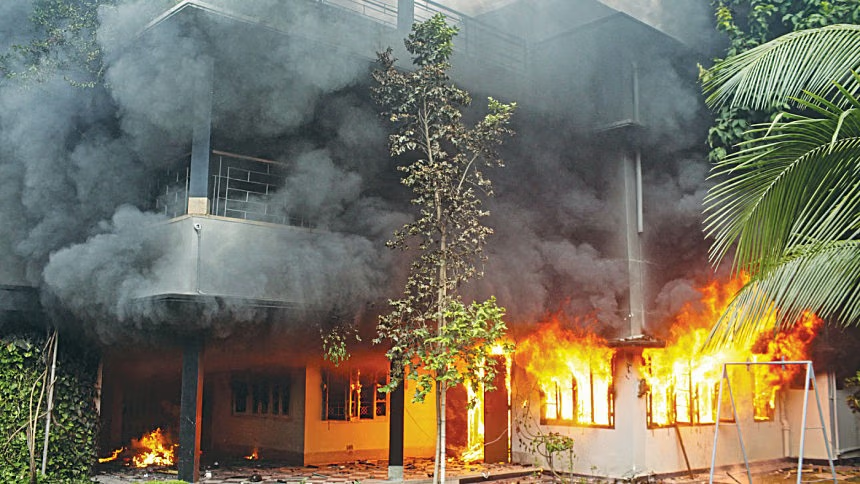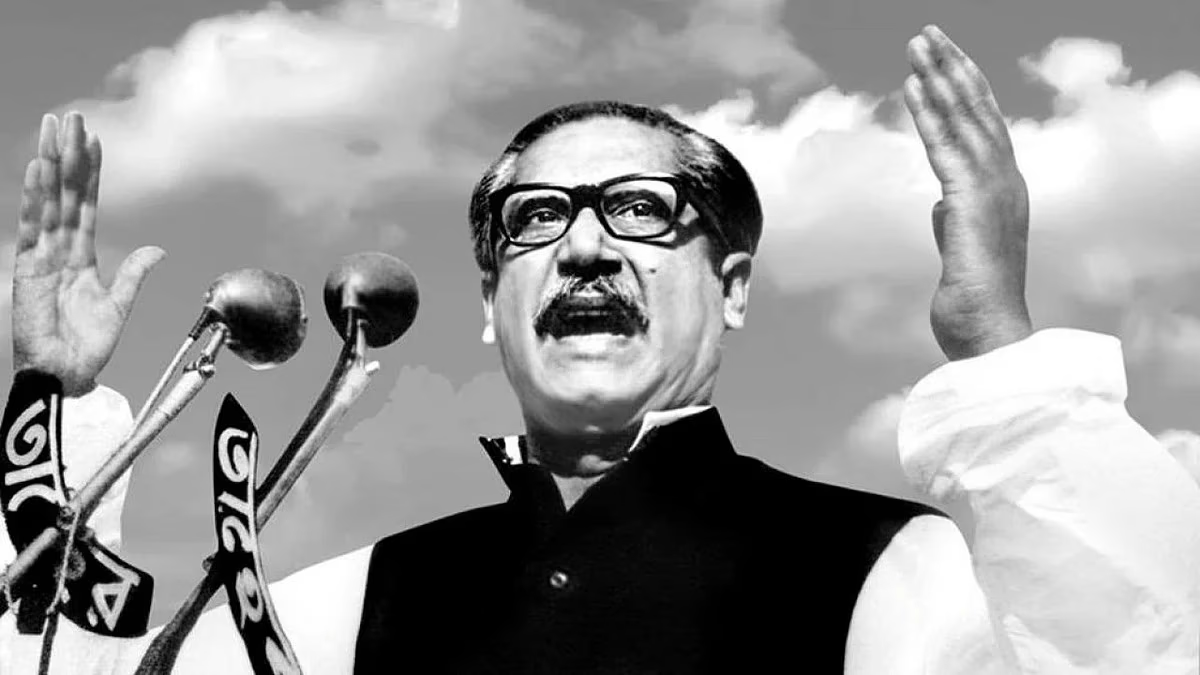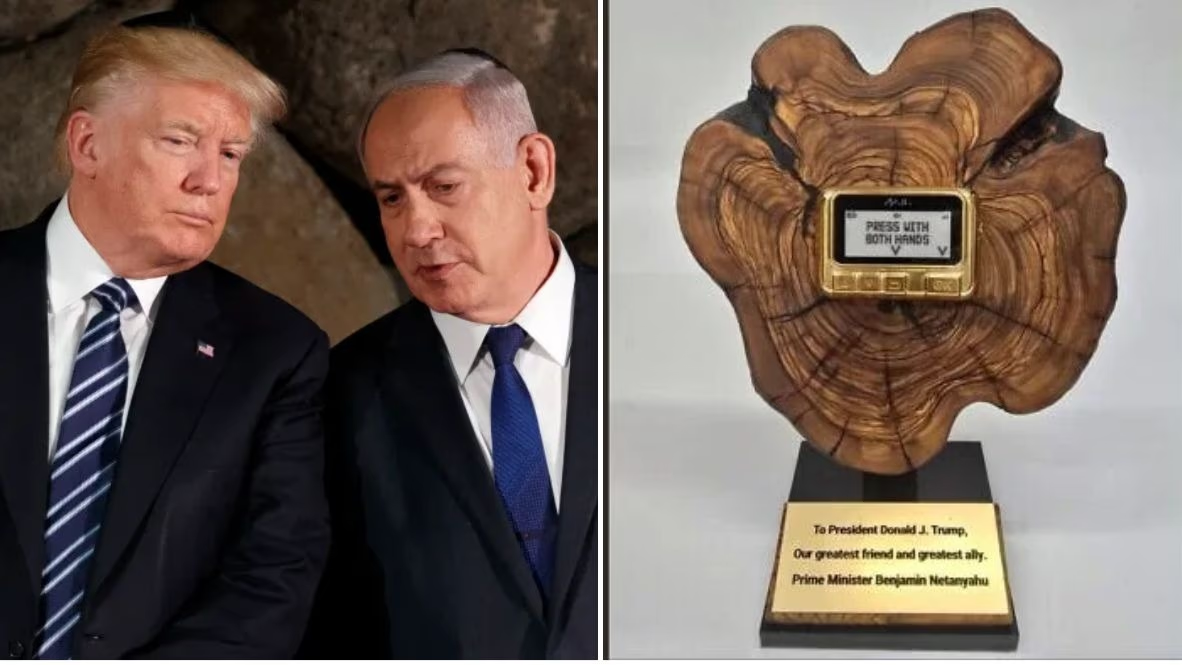As an angry crowd armed with bulldozers, shovels, hammers, and cranes storms into Dhanmondi Lane in Dhaka, the capital of Bangladesh, it resembles a dramatic scene from a movie.
Although Dhanmondi Lane has several prominent buildings, the rioters targeted Dhanmondi-32. A bulldozer demolished this structure encapsulating decades of Bangladesh's history. Hammers and chisels further damaged it, and finally, it was set ablaze. This was no ordinary house; it was the dream abode of Bangladesh's founding father, Sheikh Mujibur Rahman.
Sheikh Mujibur Rahman, with his bold defiance against Pakistan's governance, declared the trumpet call for Bangladesh's independence right from this house. Yesterday, the hammers and chisels aimed at this home symbolized an attack on Bangladesh's very existence. It was an assault not just on the house of Prime Minister Sheikh Hasina's father, known across Bangladesh as Bangabandhu, but on his pivotal contribution to the nation's freedom.
The chronicles of Bangladesh cannot be disentangled from this house. Though its roots were entwined with the oversight of West Pakistan, it was within the walls of Dhanmondi-32 that the first seeds of independence were sown. The year was 1955 when Sheikh Mujibur Rahman was elected for the first time to the East Bengal Assembly. Following the partition of India in 1947, this was the first election in East Bengal. At that time, Mujib lived at house number 15 on Abdul Gani Road.

Source: aajtak
Dhanmondi-32 Built with Loan Money
Renowned Bangladeshi scholar Dr. Jagannath Barua writes in his book
Bangabandhu 32 Number Bari
that it was in the same year the government initiated a land allocation program. Sheikh Mujib's wife, Fazilatunnesa, was eager to benefit from this government scheme. Upon expressing her desire, their personal secretary Nuruzzaman quickly filled out the form in Mujib’s name.
After a two-year wait, in 1957, a plot in Dhanmondi was allocated to Fazilatunnesa. It cost 6,000 taka. At that time, Mujib was the Chairman of the Pakistan Team Board. He paid an initial 2,000 taka upfront, with the remaining sum settled in installments. However, during this period, due to his rebellious stance, Mujib was constantly on the Pakistani military's radar, frequently changing locations to avoid arrest.
This episode is elaborately detailed in Sheikh Hasina's book
Sheikh Mujib Amar Pita
. Hasina mentions that in 1958, when Mujib was arrested, they were residing in a government house in Segunbagicha. Consequently, his family had to live in a rented home. By 1960, Fazilatunnesa realized the need for a permanent place to live in Dhaka. Hence, they began constructing the house that would later become pages of history on that Dhanmondi plot.
Building a home was no simple task for Mujib. He received help from friends and even took a loan from the House Building Finance Corporation. Finally, in 1961, they built a single-story house with three rooms.
By 1965, another floor and more rooms were added. Mujibur Rahman converted a large portion of the ground floor into a library, with another part functioning as the Awami League's office.

Source: aajtak
Dhanmondi-32: Birthplace of Many Movements
Dhanmondi-32 is no ordinary building. It has been the birthplace of numerous movements. Under Mujibur Rahman's leadership, the clarion call against Pakistani governance resonated from this very house.
The spark of the Anti-Ayub Movement ignited here in 1962. Mujib conducted secret meetings within the confines of this house, often staying up through the night. Dr. Barua notes in his book that this home quickly became the center of Eastern Bengal's politics. After the death of Hussain Shaheed Suhrawardy in December 1963, a meeting was held here on January 25, 1964. During this, Abdur Rashid was appointed as the President of Awami, while Mujib was made Secretary-General, marking a turning point for him.
In renowned Bangladeshi author Mohiuddin Ahmed's book
Awami League: Uthan Porbo 1948-1970
, it is mentioned that the historic charter of the Six Points for Bengalis was drafted here in 1966. Following the charter's preparation, Mujib announced it in Lahore.
This key political manifesto was officially approved during a meeting of the East Pakistan Awami League's executive committee on February 21, 1966, at Dhanmondi-32. In the midst of all this, Mujibur Rahman was arrested from his home on May 8. Despite his absence, the Six Points Movement continued under the stewardship of his wife, Fazilatunnesa.
When Mujib was released from prison in 1969, the drawing room of this house was where the strategy for the 1970 elections was drafted. Sensing the growing rebellion, Pakistan's dictator General Yahya Khan postponed the National Assembly session, leading to the non-cooperation movement that began on March 1, 1971.
The book claims that during this period, American ambassador Joseph Farland and General Rao Farman Ali discreetly visited Mujib's house for a highly confidential meeting. The political atmosphere indicated an impending significant change. On March 7, Mujib was scheduled to deliver a historic speech from his home. The evening before, he met with some senior party leaders. It was decided in this meeting that on March 23, Mujib would unfurl the flag of independent Bangladesh at his home, which he did.
The Pakistani military had already perceived Mujib's intentions. Hours before Bangladesh's independence was declared, Mujib held a meeting with Awami League leaders in Dhanmondi-32. However, that very night, Pakistani forces encircled his house and arrested him. But before his arrest, Mujib had already announced independence via a wireless message.
During Bangladesh's struggle for independence, Mujib's family was placed under house arrest in Dhanmondi-32 by the Pakistani army. Even after independence, Mujib continued to live here, managing the nation from this residence instead of stepping into the official Prime Minister's House.
The Blood-Soaked Walls of Dhanmondi-32
While Mujibur Rahman's abode was a bastion of independence and hosted numerous foreign dignitaries, including Indira Gandhi and Egypt's President Anwar Sadat, its walls have been stained with blood.
On the night of August 15, 1975, during a military coup in Bangladesh, Sheikh Mujibur Rahman and his entire family were brutally murdered in this house. His daughters, Sheikh Hasina and Sheikh Rehana, survived the massacre as they were in Germany at the time.




